Java
> Drone
> Tech
> Computer Science
> Software
> Dev
> Language
Java Tmp news
Eclipse (Java tuto)
Java EE 7 with Angular JS – Part 1. Today’s post will show you how to build a very simple application using Java EE 7 and Angular JS.

Before going there let me tell you a brief story: I have to confess that I was never a big fan of Javascript, but I still remember the first time I have used it. I don’t remember the year exactly, but probably around mid 90′s. I had a page with 3 frames (yes frames! Remember those?
Java history
Java Sun / Oracle. Java version history. After the Java 7 release, Oracle promised to go back to a 2 year release cycle.[1] However, in 2013, Oracle announced that they would delay Java 8 by one year, in order to improve the Java security model.[2] JDK Alpha and Beta (1995)[edit] Alpha and Beta Java public releases had highly unstable APIs and ABIs.
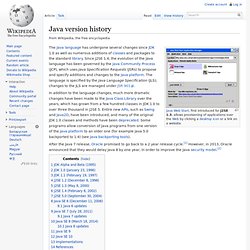
The supplied Java web browser was named WebRunner. JDK 1.0 (January 23, 1996)[edit] Note : In versions of Java and the JDK up to 1.0.1, private and protected keywords could be used together to create yet another form of protection that would restrict access to methods or variables solely to subclasses of a given class. JDK 1.1 (February 19, 1997)[edit] Major additions included:[5] J2SE 1.2 (December 8, 1998)[edit] Codename Playground. J2SE 1.3 (May 8, 2000)[edit]
7 Releases by Date. Java SE EOL Policy (Oracle Java SE Support Roadmap)
Oracle provides this updated roadmap for Oracle Java SE products (Oracle Java SE Advanced, Oracle Java SE Advanced Desktop and Oracle Java SE Suite) to help customers understand the maintenance and support options available.

Starting September 2017, Oracle has moved to a "Long Term Support" (LTS) model for Oracle Java SE products. This means that LTS versions, offering Premier and Sustaining Support, will be targeted for release every three years. In addition, feature releases will be targeted for every six months along with quarterly maintenance/security updates. A short video is available providing an overview of these "Changes to the JDK Release Model". The following provides a more detailed review of the Java SE products support roadmap, along with examples specific to available major releases. End of Public Updates for Oracle JDK 8. Java SE Support Roadmap. End of Java 7 Public Updates.
JPortable
Java Oops. Potential Warning. Java and other Language. Applet Java and HTML. GWT et PureMVC - ViaXoft. La mise en œuvre d’une application RIA robuste, mai ntenable, réutilisable et évolutive nécessite l’utilisation des modèles de conceptions éprouvés.
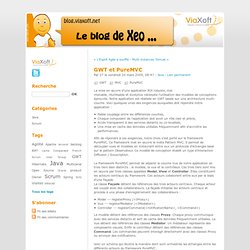
Notre application est réalisée en GWT basée sur une architecture multi-couche. Voici quelques unes des exigences auxquelles doit répondre notre application : Faible couplage entre les différentes couches,Chaque composant de l’application doit avoir un rôle clair et précis,Accès transparent à des services distants ou co-localisés,Une mise en cache des données utilisées fréquemment afin d’accroître les performances. Afin de répondre à ces exigences, notre choix s’est porté sur le framework PureMVC. Ce framework met en œuvre le méta Pattern MVC. Le framework PureMVC permet de séparer la couche Vue de notre application en trois tiers bien distincts : le modèle, la vue et le contrôleur.
JavaCard
PureMVC. Java Network Launching Protocol (JNLP)
World Wind JAVA SDK. Java & Lib. Apprendre Java. General (Java)
Développons en Java - Les annotations. Java SE 5 a introduit les annotations qui sont des métadonnées incluses dans le code source.
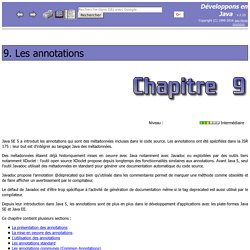
Les annotations ont été spécifiées dans la JSR 175 : leur but est d'intégrer au langage Java des métadonnées. Des métadonnées étaient déjà historiquement mises en oeuvre avec Java notamment avec Javadoc ou exploitées par des outils tiers notamment XDoclet : l'outil open source XDoclet propose depuis longtemps des fonctionnalités similaires aux annotations. Avant Java 5, seul l'outil Javadoc utilisait des métadonnées en standard pour générer une documentation automatique du code source.
Javadoc propose l'annotation @deprecated qui bien qu'utilisée dans les commentaires permet de marquer une méthode comme obsolète et de faire afficher un avertissement par le compilateur. Le défaut de Javadoc est d'être trop spécifique à l'activité de génération de documentation même si le tag deprecated est aussi utilisé par le compilateur. Ce chapitre contient plusieurs sections : 9.1.
URL (Java)
Mehod tests. Gui. System. Memory (Java)
Java/Security & Crypto. JNI. Regular Expression. Threading & synchronization. SGBD. Date time Java. Difference between Singleton Pattern vs Static Class in Java. Singleton pattern vs Static Class (a class, having all static methods) is another interesting questions, which I missed while blogging about Interview questions on Singleton pattern in Java.

Since both Singleton pattern and static class provides good accessibility, and they share some similarities e.g. both can be used without creating object and both provide only one instance, at very high level it looks that they both are intended for same task. Because of high level similarities, interviewer normally ask questions like, Why you use Singleton instead of Static Methods, or Can you replace Singleton with static class, and what are differences between Singleton pattern and static in Java. In order to answer these question, it’s important to remember fundamental difference between Singleton pattern and static class, former gives you an Object, while later just provide static methods.
XML
Generic in Java. Java annotation. Développer en Java. String Enconding (UTF-8 included)
Data / structure / IO. Java Dev Tools & tips. Festselenium - fest + selenium for applet automation testing. In-browser applet testing can now be accomplished using festselenium in conjunction with Selenium RC.
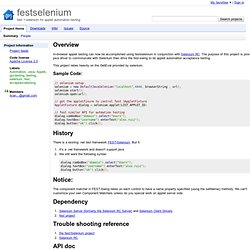
The purpose of this project is provide a java driver to commnuicate with Selenium then drive the fest-swing to do applet automation acceptance testing. This project relies heavily on the GetEval provided by selenium. Sample Code: // selenium setupselenium = new DefaultJavaSelenium("localhost",4444, browserString , url);selenium.start();selenium.open(url); // get the appletfixure to control fest JAppletFixtureAppletFixture dialog = selenium.applet(LIST_APPLET_ID) // fest similar API for autmation testingdialog.comboBox("domain").select("Users");dialog.textBox("username").enterText("alex.ruiz");dialog.button("ok").click(); There is a exsting .net test framework FEST-Selenium.
It's a .net framework and doesn't support java We still want the following syntax: dialog.comboBox("domain").select("Users");dialog.textBox("username").enterText("alex.ruiz");dialog.button("ok").click(); import javax.swing.
Stand-Alone Java Application
Download JDK (Archive)
Java Debug. Traces (java/deployment/log)
Java Applet. Servlet. Java Platform Debugger Architecture. Java Debugger Interface (JDI) - defines a high-level Java language interface that developers can easily use to write remote debugger application tools.Java Virtual Machine Tools Interface (JVMTI), a native interface that helps to inspect the state and to control the execution of applications running in the Java Virtual Machine (JVM).Java Virtual Machine Debug Interface (JVMDI)- JVMDI was deprecated in J2SE 5.0 in favor of JVM TI, and was removed in Java SE 6.Java Debug Wire Protocol (JDWP) - defines communication between debuggee (a Java application) and debugger processes.
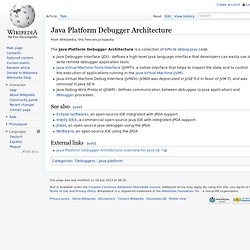
See also[edit] External links[edit]
FAQ/Developing. About This section of the FAQ discusses common questions related to Tomcat development.
JSP Quick Guide. What is JavaServer Pages?

JavaServer Pages (JSP) is a technology for developing web pages that support dynamic content which helps developers insert java code in HTML pages by making use of special JSP tags, most of which start with <% and end with %>. A JavaServer Pages component is a type of Java servlet that is designed to fulfill the role of a user interface for a Java web application. Web developers write JSPs as text files that combine HTML or XHTML code, XML elements, and embedded JSP actions and commands.
Interview avec James Gosling, Le Père du Java.
Apache CXF
Hibernate / Thorben Janssen.









